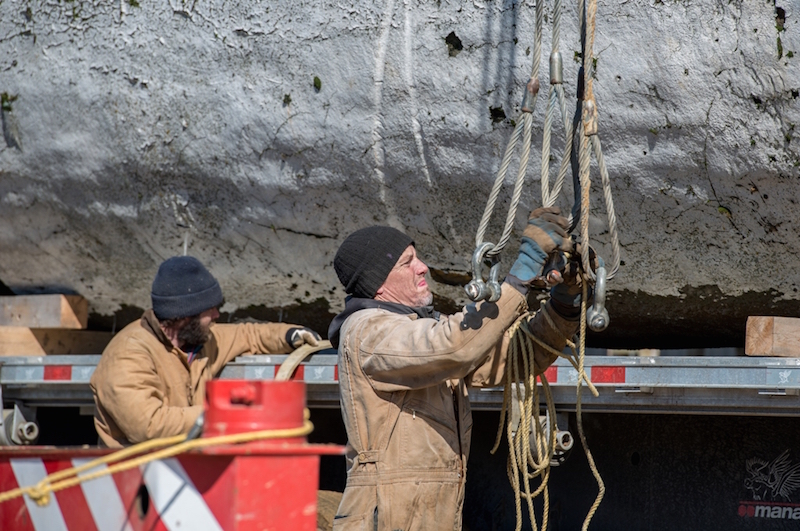What is 26,000 pounds, 45-feet long and spins all over? An in-vessel composter, that’s what.
On Monday, as a winter snowstorm barreled through mainland Massachusetts, John Keene Excavation transported the 13-ton cylindrical composter from Saugus to the Vineyard. The 12-hour journey involved almost 100 feet of flatbed trucks and under one foot of highway clearance. But by the end of the day, Island Grown Initiative had the ability to compost three times as much food waste as they could in the past — without the stench of noxious fumes or fear of pesky rodents.
“I’m not sure there is another in-vessel composter on the Island right now,” said IGI’s executive director, Rebecca Haag. “It’s a much faster process and it can handle much more food waste.”

In the past, IGI, an Island nonprofit dedicated to providing sustainable and healthy food, has used wind row composting to process food waste. Wind row composting mixes the waste with carbon materials then lets it sit out in rows to dry, leaving the compost subject to birds and beasts, and humans subject to malodorous scents. But an in-vessel composter does all the work itself, processing the food waste inside at three times the speed.
“After it’s been rolling and it comes out it no longer has any food particles in it, and it doesn’t smell at all,” Ms. Haag said. “No rodent issues, no bird issues.”
Last year, IGI processed 120 tons of food waste alone. But Ms. Haag estimates that’s only a small amount of the total 6,500 tons of food waste that get shipped off the Island every year. Ms. Haag hopes the in-vessel composter, purchased for $35,000, will help save as much of that food waste as possible, using it to both enrich soil on their farm and sell it to others. IGI also has 500 egg-laying chickens, all of whom, coincidentally, love to eat garbage.
“Part of our intent in bringing the in-vessel to the Island is to demonstrate that instead of using fossil fuels to ship food off, we can reduce the amount of compost you need to import and actually increase its quality,” Ms. Haag said. “We want to demonstrate the machine’s efficacy. It’s a good way for the Island to be more self-sufficient and support a regenerative approach to agriculture.”

Getting the composter to Martha’s Vineyard was an Island-wide effort as well. Stevie and Derek Araujo, employees of John Keene Excavation, took a 6 a.m. ferry with two 40-plus foot flatbeds. There was a foot of snow on the ground when they arrived in Saugus.
“That was crazy,” Mr. Keene said. “You can imagine it took a while to get it loaded to be the right height for the highway.”
The duo then drove the two hours back to Wood’s Hole, worried at every highway overpass that the composter would collide and go barreling down the road. Luckily, they made it on the 6:15 p.m. boat without incident. The trucks extended the length of the ferry.
“It just barely fit on the boat,” Mr. Keene said. “And the whole way down they were wondering if it was going to fit...they were incredible, they made it happen. They could have given up, but they didn’t.”
When they arrived at IGI, Mr. Keene and crew positioned the composter on pre-set concrete pads, lifting it with a crane and pulling it with a farm tractor. Despite mud, snow and bitter cold the undertaking was a success.
“It’s sort of a typical Vineyard story, isn’t it?” Ms. Haag said. “Nothing comes easy on the Island.”







Comments (2)
Comments
Comment policy »